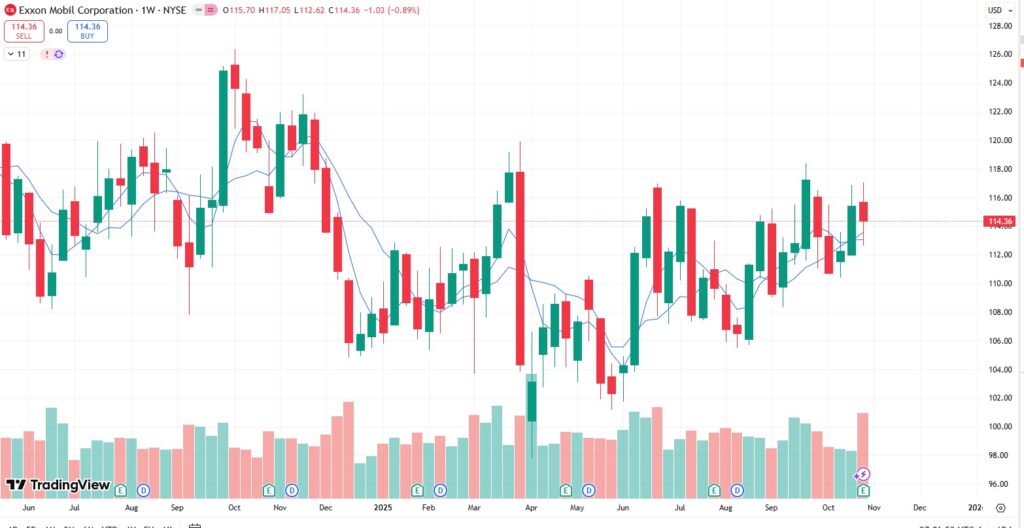
ExxonMobil Corporation (XOM) delivered a powerhouse performance in the third quarter of 2025, underscoring its operational prowess amid a challenging energy landscape. The company reported GAAP earnings of $7.5 billion, or $1.76 per share, marking an increase from $7.1 billion in the prior quarter. Excluding identified items, adjusted earnings reached $8.1 billion, or $1.88 per share, surpassing analyst expectations of $1.82 per share.
This success was fueled by record-breaking production in key regions, robust cash flows, and strategic advancements that position the energy giant for sustained growth. But what does this mean for investors eyeing the volatile oil and gas sector? Let’s break it down, including insights from the earnings report, forward-looking guidance, and the broader market dynamics shaping Q4 2025. Stellar Q3 Financials and Operational MilestonesExxonMobil’s Q3 results were a testament to its efficiency and scale. Cash flow from operating activities hit $14.8 billion, while free cash flow came in at $6.3 billion.
Year-to-date earnings stood at $22.3 billion, down from $26.1 billion in the same period of 2024 due to softer commodity prices, but the company remains on track with its cost-saving initiatives, having achieved $14.3 billion in structural reductions since 2019.
The standout story was production. Upstream net output averaged 4.8 million oil-equivalent barrels per day (koebd), up 139,000 koebd from Q2.

Guyana led the charge with quarterly production exceeding 700,000 barrels per day for the first time, bolstered by the early startup of the Yellowtail project—four months ahead of schedule and under budget, adding 250,000 koebd of capacity.
Do you live in California, New York, or New Jersey and have a Tax issue?
This brings Guyana’s total installed capacity to over 900,000 koebd. In the Permian Basin, output hit a record of nearly 1.7 million koebd, driven by innovative technologies like lightweight proppant, which boosts well recoveries by up to 20%.
Downstream segments also shone. Energy Products earnings reached $1.8 billion, supported by record refinery throughput (the highest since the Exxon-Mobil merger on a same-site basis).
Chemical Products hit record high-value product sales, while Specialty Products contributed $740 million in earnings.
Strategically, ExxonMobil acquired over 80,000 net acres in the Permian from Sinochem Petroleum and key assets from Superior Graphite to enter the battery anode materials market, signaling a pivot toward energy transition opportunities.
The commissioning of the Discovery 6 supercomputer, in partnership with HPE and NVIDIA, promises to accelerate data processing and unlock over $1 billion in value from enhanced resource recovery.
Shareholder returns remained a priority, with $9.4 billion distributed in Q3—$4.2 billion in dividends and $5.1 billion in buybacks.
Year-to-date, this totals $27.8 billion, aligning with the $20 billion annual repurchase target.
The company also hiked its Q4 dividend by 4% to $1.03 per share, marking 43 consecutive years of annual increases.
Future Guidance: Bullish on Growth and Innovation
Looking ahead, ExxonMobil’s leadership exudes confidence. CEO Darren Woods emphasized the company’s unique position: “We’re executing at unmatched scale and innovation, delivering record production in Guyana and the Permian.”
The firm has started eight of its 10 key 2025 projects, with the remaining two (including the Golden Pass LNG) on track for year-end.
These are projected to add over $3 billion in earnings in 2026 at constant prices and margins.
Permian growth is expected to continue well into the next decade, with proppant technology adoption ramping to 25% of wells in 2025 and 50% by 2026.
In Guyana, the Hammerhead project was sanctioned, set to add 150,000 koebd by 2029.
Cost savings are targeted to exceed $18 billion by 2030, and full-year 2025 cash CapEx is forecasted slightly below the $27-29 billion range (excluding acquisitions).
Emerging ventures like Proxima (tripling capacity in 2025) and battery graphite (offering 30% faster charging and up to four times longer life) highlight diversification efforts.
Low-carbon solutions, including carbon-abated power for data centers, are progressing, though paced to match market demand.
An updated corporate plan will be shared on December 9, 2025.
Globally, the company anticipates 20% gas growth and doubling of LNG demand over the next 25 years, justifying investments in low-cost production.
Challenges include slower-than-expected low-carbon market development and competitive exploration landscapes, but ExxonMobil’s integrated model and technology edge are seen as mitigants.
The Broader Oil and Gas Market: Supply Glut Looms in Q4While ExxonMobil thrives, the global oil market faces headwinds. The U.S. Energy Information Administration (EIA) forecasts Brent crude averaging $62 per barrel in Q4 2025, dropping to $52 per barrel in the first half of 2026, driven by oversupply.
Global liquid fuels production is expected to rise by 2.7 million b/d in 2025 to 105.9 million b/d, outpacing demand growth of 1.1 million b/d to 104.0 million b/d.
This imbalance will lead to inventory builds of 2.6 million b/d in Q4 2025, potentially pushing prices lower as storage fills.
Non-OPEC+ nations like the U.S., Brazil, Canada, and Guyana will drive supply growth, adding 2.0 million b/d in 2025.
OPEC+ may increase output by 0.5 million b/d, though constrained by spare capacity.
Demand is led by non-OECD countries, particularly Asia (India and China adding over 0.4 million b/d by 2026), but OECD consumption dips slightly in 2025.
Key risks include geopolitical tensions (e.g., Russia-Ukraine), U.S. tariffs, and China’s strategic stockpiling slowdown.
For natural gas, the International Energy Agency (IEA) projects demand growth of less than 1% in 2025, with unprecedented LNG supply scaling up to enhance security and affordability.
This could ease prices but highlights the sector’s shift toward LNG amid global energy transitions.
Implications for Investors
ExxonMobil’s Q3 results affirm its resilience in a low-price environment, with record outputs and shareholder-friendly moves like dividend hikes and buybacks making it a defensive play for income-focused investors. The company’s $3 billion+ earnings boost from 2025 projects and diversification into batteries and low-carbon tech suggest long-term upside, even as oil prices soften.
However, the Q4 oversupply risk could pressure near-term margins, rewarding those with a contrarian view on ExxonMobil’s cost advantages and execution edge.
In a market bracing for $52 Brent in 2026, ExxonMobil’s “league of our own” status—per CEO Woods—positions it to outperform peers.
Investors should monitor OPEC+ decisions and demand signals from Asia, but for those betting on integrated majors, XOM remains a compelling hold with strong total return potential.
Oil companies cannot survive on $52 oil, and Natural Gas is going to become more critical. We are seeing in the US rig counts that natural gas rigs are remaining working, while the oil rigs are being stood down. As oil demand looks strong and supply is falsely reported as a glut, prices will rise. At $65, you will see some drilling activity remain stable, but oil companies are going to be spending their CapEx budgets where they can capitalize on existing infrastructure and maximize outputs.
For investors and Data Centers, you will want to look at getting as close to the wellhead as you can and look to invest in privately held opportunities that will offer returns even at the $65 range and be prepared for the $75 to $85 spikes.
Got Questions on investing in oil and gas?
ENB Top News
ENB
Energy Dashboard
ENB Podcast
ENB Substack






Be the first to comment